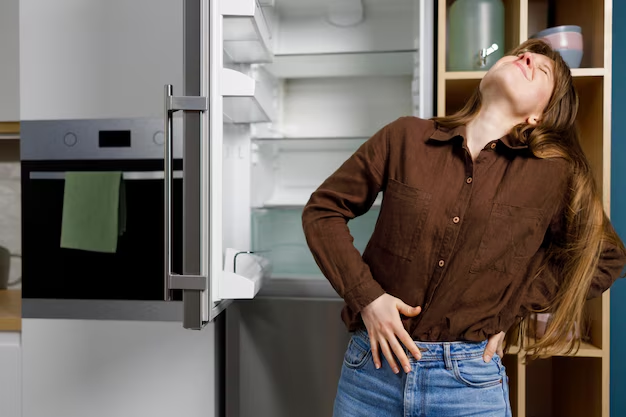Understanding the Ideal Refrigerator Temperature Range: Everything You Need to Know
Imagine opening your refrigerator to find your milk slightly sour and your veggies wilting faster than they should. While it's frustrating, these issues might have a simple solution: adjusting your refrigerator's temperature. The right refrigerator temperature not only keeps your food fresher for longer but can also prevent health risks associated with food spoilage. Let's dive into this topic and explore everything you need to know about maintaining the optimal refrigerator temperature range.
🌡️ Why Refrigerator Temperature Matters
Keeping your refrigerator at the right temperature is crucial for food safety and preservation. Keeping your appliances too warm can lead to bacterial growth, while setting them too cold can freeze and damage food items. A well-maintained temperature ensures that perishable foods like meat, dairy, and vegetables remain fresh and safe for consumption.
The Ideal Temperature Range
The general consensus suggests that refrigerators should be set between 35°F and 38°F (1.6°C - 3.3°C). This range is cold enough to slow bacteria growth yet warm enough to prevent food from freezing. Your freezer, on the other hand, should be at 0°F (-18°C) to preserve food for extended periods.
🥗 How Temperature Affects Different Food Groups
Dairy Products
Dairy items like milk, cheese, and yogurt are especially sensitive to temperature fluctuations. If stored above 40°F (4.4°C), these products are at risk of spoiling quickly. Aim to store these items in the coldest part of your refrigerator, typically towards the back.
Meat and Poultry
Raw meat and poultry should always be stored in the coldest section to prevent bacterial contamination. Keeping meats at a temperature below 40°F is critical to avoid foodborne illnesses.
Fruits and Vegetables
Fruits and vegetables have varying temperature needs. Lettuce and other leafy greens prefer slightly warmer temperatures than meats, while berries thrive in cooler environments. For optimal freshness, separate fruits and vegetables, as some fruits emit ethylene gas, which can hasten the spoilage of nearby produce.
🔧 How to Check and Adjust Your Refrigerator's Temperature
Checking the Temperature
Most modern refrigerators come with a built-in thermometer or digital readout. If your appliance lacks this feature, you can purchase a standalone refrigerator thermometer. Place it in a central or most commonly used part of the fridge for an accurate reading.
Adjusting the Temperature
To adjust the temperature, consult your refrigerator’s manual for specific instructions. Generally, you'll find a dial or digital setting that allows you to make adjustments. After changing the temperature, give your fridge 24 hours to stabilize before checking it again.
🚫 Common Mistakes and How to Avoid Them
Overloading the Fridge
Packing your refrigerator too full can obstruct air circulation, leading to warm spots and uneven cooling. Tip: Arrange items so that there is ample space for air to move around, ensuring even temperature distribution.
Frequent Door Opening
Constantly opening and closing the refrigerator door affects the internal temperature. If possible, plan ahead, and retrieve multiple items at once to reduce door openings.
Door Seals and Insulation
A worn or broken door seal can lead to temperature fluctuations in your refrigerator. Check regularly for cracked or damaged seals and replace them as necessary to maintain temperature stability.
🧐 Exploring Related Topics
How Humidity Settings Impact Food Preservation
Some refrigerators offer humidity control options, commonly found in vegetable and fruit drawers. Understanding and utilizing these settings can significantly improve the lifespan of your produce. High humidity is suitable for leafy greens, whereas low humidity is better for most fruits.
The Role of Energy Efficiency
Keeping your refrigerator at an optimal temperature can also enhance its energy efficiency. When set too cold, it can unnecessarily increase energy consumption. Balancing your temperature settings can thus contribute to lower energy bills.
🤔 FAQs About Refrigerator Temperature
Q: Can I set my refrigerator temperature lower than 35°F to make it extra cold?
A: It's generally not recommended, as temperatures below 35°F can cause some items to freeze, impacting both texture and taste.
Q: What’s the best way to store leftovers?
A: Store leftovers in airtight containers at the recommended temperature range, and try to refrigerate them within two hours of cooking for safety and freshness.
Q: How often should I check my fridge’s temperature?
A: Checking once a month is advisable for maintaining optimal temperatures and catching any issues early.
📋 Quick Tips for Optimal Refrigerator Temperature
Here's a concise list to ensure your refrigerator is set correctly for safety and efficiency:
- 🕵️♂️ Monitor Regularly: Use a thermometer to routinely check your fridge’s temperature.
- 🥶 Ideal Temperature: Keep the fridge between 35°F and 38°F (1.6°C - 3.3°C).
- 🚪 Mind the Door: Avoid overfilling and frequent door openings to maintain a steady temperature.
- 🛠️ Seal Check: Ensure door seals are intact for efficient cooling.
- 🌽 Separate Produce: Use humidity settings to extend the life of fruits and vegetables.
Keeping a keen eye on your refrigerator's temperature not only prolongs the life of your groceries but also safeguards your health. By understanding and implementing these settings effectively, you can enhance food safety and make efficient use of energy, providing peace of mind every time you open your fridge door.
Through these practical steps, managing refrigerator temperature becomes a straightforward task, allowing you peace of mind while ensuring food safety and longevity. This nuanced understanding is essential for anyone keen on maintaining a healthy, cost-effective, and environmentally friendly kitchen environment.
